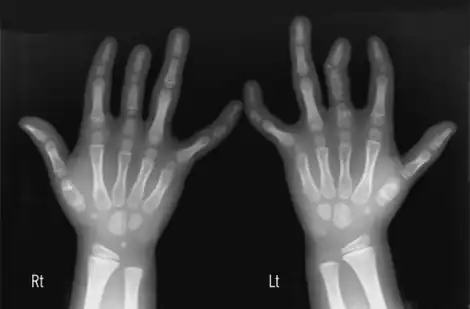Brachydactyly
| Brachydactyly | |
|---|---|
 | |
| Different forms of brachydactyly | |
Brachydactyly (Greek βραχύς = "short" plus δάκτυλος = "finger"), is a medical term which literally means "short finger". The shortness is relative to the length of other long bones and other parts of the body. Brachydactyly is an inherited, usually dominant trait. It most often occurs as an isolated dysmelia, but can also occur with other anomalies as part of many congenital syndromes. Brachydactyly can also be a signal that one will be at risk for heart problems as they age.
Nomograms for normal values of finger length as a ratio to other body measurements have been published. In clinical genetics, the most commonly used index of digit length is the dimensionless ratio of the length of the third (middle) finger to the hand length. Both are expressed in the same units (centimeters, for example) and are measured in an open hand from the fingertip to the principal creases where the finger joins the palm and where the palm joins the wrist.
Types
There are several types of Brachydactyly:

| Type | OMIM | Gene | Locus | Also known as/Description |
| Type A1, BDA1 | 112500 | IHH BDA1B | 5p13.3-p13.2, 2q33-q35 | Brachydactyly type A1 or Farabee-type brachydactyly. BDA1 is an autosomal dominant inherited disease. Features include: Brachydactyly, Short or absent phalanges, Extra carpal bones, Hypoplastic or absent ulna and Short metacarpal bones. |
| Type A2, BDA2 | 112600 | BMPR1B GDF5 | 20q11.2, 4q23-q24 | Brachydactyly type A2, Brachymesophalangy II or Brachydactyly Mohr-Wriedt type. Type A2 is a very rare form of brachydactyly. The phalanges of the index fingers and second toes are shortened. |
| Type A3, BDA3 | 112700 | Brachydactyly type A3, Brachymesophalangy V or Brachydactyly-Clinodactyly. | ||
| Type A4, BDA4 | 112800 | Brachydactyly type A4, Brachymesophalangy II and V or Brachydactyly Temtamy type | ||
| Type A5, BDA5 | 112900 | Brachydactyly type A5 nail dysplasia. | ||
| Type A6, BDA6 | 112910 | Brachydactyly type A6 or Osebold-Remondini syndrome. | ||
| Type A7, BDA7 | Brachydactyly type A7 or Brachydactyly Smorgasbord type.[1] | |||
| Type B, BDB (or BDB1) | 113000 | ROR2 | 9q22 | Brachydactyly type B. |
| Type C, BDC | 113100 | GDF5 | 20q11.2 | Brachydactyly type C or Brachydactyly Haws type. |
| Type D, BDD | 113200 | HOXD13 | 2q31-q32 | Brachydactyly type D. Referred to inaccurately ("clubbing is a clinically descriptive term, referring to the bulbous uniform swelling of the soft tissue of the terminal phalanx of a digit")[2] as "clubbed thumbs". |
| Type E, BDE | 113300 | HOXD13 | 2q31-q32 | Brachydactyly type E. |
| Type B and E | 112440 | ROR2 HOXD13 | 9q22, 2q31-q32 | Brachydactyly types B and E combined, Ballard syndrome or Pitt-Williams brachydactyly. |
| Type A1B, BDA1B | 607004 | 5p13.3-p13.2 | Brachydactyly type A1, B. | |
Other syndromes
In the above brachydactyly syndromes, short digits are the most prominent of the anomalies, but in many other syndromes (Down syndrome, Rubinstein–Taybi syndrome, etc.), brachydactyly is a minor feature compared to the other anomalies or problems comprising the syndrome.
See also
References
- ↑ Meiselman SA, Berkenstadt M, Ben-Ami T, Goodman RM (1989). "Brachydactyly type A-7 (Smorgasbord): a new entity". Clin. Genet. 35 (4): 261–7. doi:10.1111/j.1399-0004.1989.tb02940.x. PMID 2714013. S2CID 30099363.
- ↑ "Clubbing of the Nails: Background, Pathophysiology, Epidemiology". 15 July 2021. Archived from the original on 20 November 2021. Retrieved 7 November 2021.
{{cite journal}}: Cite journal requires|journal=(help)
External links
| Classification |
|---|
- Type A2
- Brachydactyly type A1 at NIH's Office of Rare Diseases
- Brachydactyly type A2 at NIH's Office of Rare Diseases
- Brachydactyly type A3 at NIH's Office of Rare Diseases
- Brachydactyly type A6 at NIH's Office of Rare Diseases
- Brachydactyly type A7 at NIH's Office of Rare Diseases
- Brachydactyly type B at NIH's Office of Rare Diseases
- Brachydactyly type C at NIH's Office of Rare Diseases
- Brachydactyly type E at NIH's Office of Rare Diseases
- Brachydactyly types B and E combined at NIH's Office of Rare Diseases